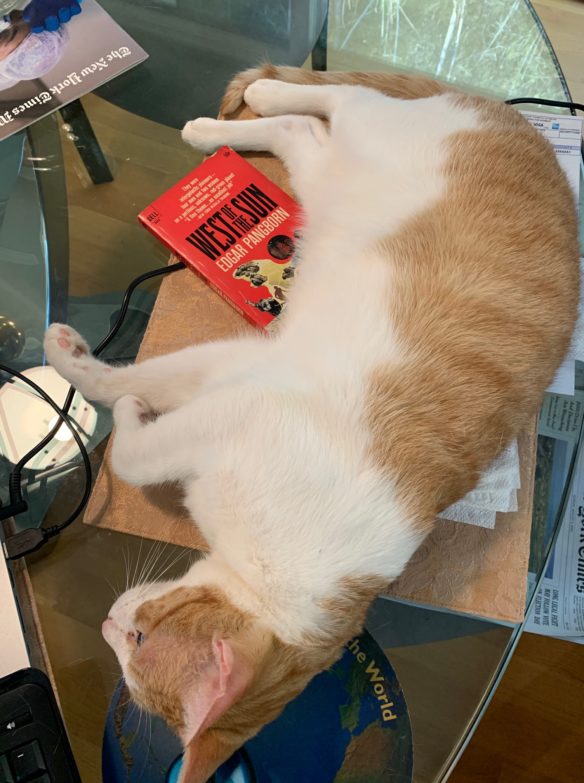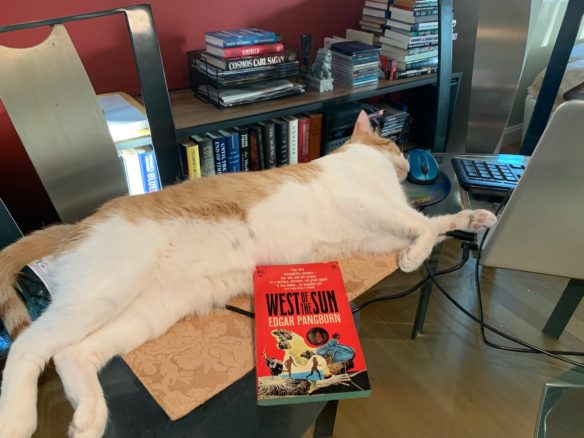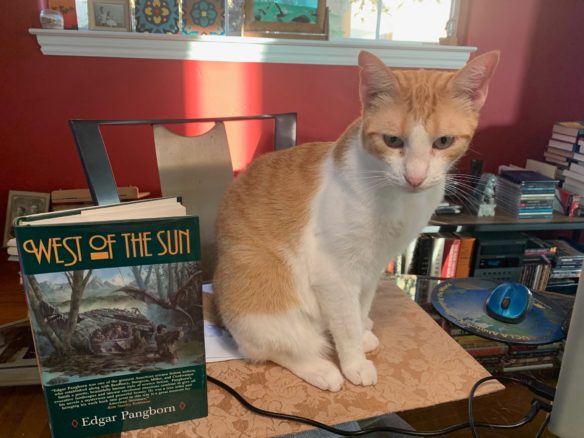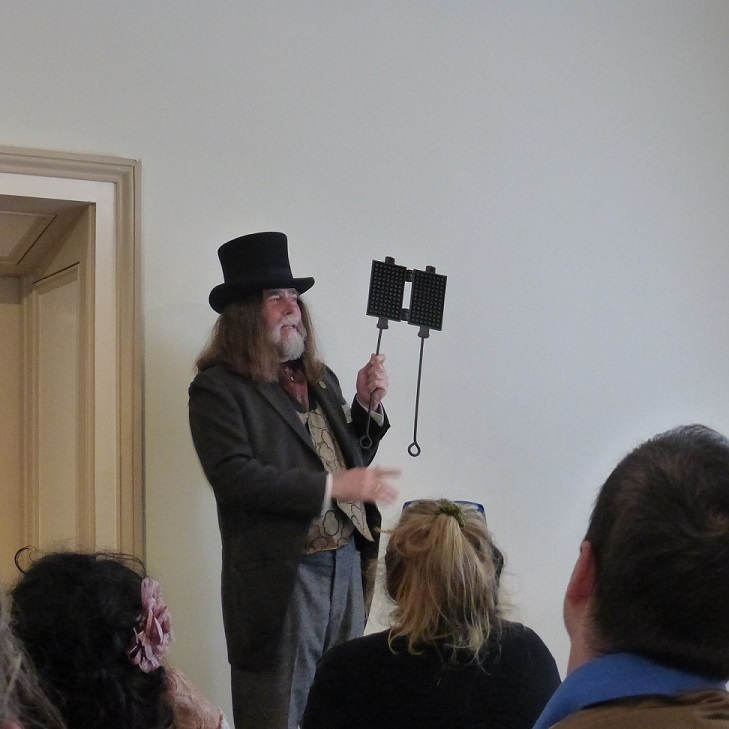(1) FREE WOLVES. The first episode of Raised By Wolves is free on YouTube – SYFY Wire has the story:
Those interested in blasting off to a distant world filled with strife and android parents are in luck: HBO Max has put the entire first episode of its new sci-fi show, Raised By Wolves, on YouTube for free.
(2) BUTLER ON BESTSELLER LIST. SYFY Wire celebrates Octavia Butler’s posthumous breakthrough to the NY Times Bestseller List: “Author Octavia Butler Reaches New York Times Best Seller List, 14 Years After Her Death”.
It may have taken more than 44 years since the publication of her first-ever novel, but one of Octavia E. Butler‘s books has finally made it into the New York Times Best Seller List — something the widely-acclaimed science fiction author had envisioned for herself several years ago.
The novel to reach the list is 1993’s The Parable of the Sower, which offers an uncanny, but no less prescient glimpse at California in the early 2020s, a dystopian future where people are dealing with global climate change, as well as an economic crisis.
This is the book’s first time on the NYTimes Paperback Trade Fiction list, where it currently sits at no. 13, though future weeks could see it rise, if not stay, due to both Butler’s cultural impact as an author, as well as the plot’s renewed relevance, given the current global climate — not unlike the surge in popularity seen by other dystopian novels following the 2016 election, such as Margaret Atwood‘s The Handmaid’s Tale and George Orwell‘s 1984. The book is currently a bestseller on Amazon, where it’s also No. 1 in the African American Science Fiction category….
(3) ANTHOLOGY ROUNDUP. Mark R. Kelly, whose Science Fiction Awards Database is an incredible resource, told Facebook readers today he has expanded its usefulness in another direction: Anthologies.
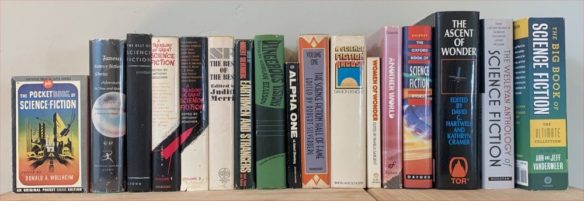
Over at my science fiction awards website, sfadb.com, I have — after a year of work — greatly expanded the section about anthologies. There are now 118 pages compiling over 1400 anthologies, grouped by editor or theme and arranged chronologically, with descriptions, photos, tallies of authors and sources, and composite tables of contents. Total descriptive text on the 118 pages: about 30,000 words. There will always be more books to compile, of course, but for now I’m considering this done. Comments, corrections, and suggestions welcome.
(4) WE THE CHARACTERS. If only school had been like this: “The Daily Heller: The U.S. Constitution in Pictures” at Print Magazine.

The Constitution Illustrated (Drawn & Quarterly) is so easy to read (and inexpensive to buy) that even a man-child U.S. President might learn something about the laws, precepts and rights bequeathed to the nation he leads. R. Sikoryak, comics artist, cartoon historian and now Constitutional scholar, has drafted the styles of many of America’s great past and present comic strip artists (of all religions, creeds, genders and social backgrounds) —from Alex Raymond’s “Flash Gordon” to Hank Ketcham’s “Dennis the Menace” to Alice Bechdel’s “Dykes to Watch Out For” to Nicole Hollander’s “Sylvia” to Frederick Burr Opper’s “Happy Hooligan” to, whew, Art Spiegelman’s “Maus,” and many, many others.
(5) GREEN ASTRONAUT TO RED PLANET. The New York Times says now is the time to watch Away, Hilary Swank’s Martian Odyssey.
‘Away’
When to watch: Now, on Netflix.
Where has Hilary Swank been the past few years? En route to Mars. This 10-episode drama stars Swank as Emma Green, the mission commander on the first manned (womanned?) mission to Mars.
In space, disaster lurks around every asteroid. Back on earth, Emma’s husband (Josh Charles) and their daughter (Talitha Bateman) face their own crises. Should Emma complete her mission or return home to care for her family? Working moms have it rough! Swank, backed by a nifty international cast, commits with her usual live-wire intensity. But the vibe remains gloomy and the heart-wringing, like the vast expanse outside the shuttle, goes on and on and on. Guess you can cry in space.
(6) FRODO AND SAM. Quite a thoughtful post by Mary Nikkel from 2019.
…By contrast, Frodo’s obstacles are primarily internal. He endured a lot of those same exterior challenges as Sam, but Sam did much to absorb their impact (see the Cirith Ungol rescue). Frodo’s challenges are the slow, steady erosion of a soul being asked to carry a tremendous internal darkness without being consumed by it. Everything he was became laser-focused on that monolithic spiritual and emotional task.
This is why, at the end, Frodo had to sacrifice far more than Sam. Because Sam’s primary struggle was against external forces, once those external forces were alleviated, he could go home, marry, have children, live as a functional member of his community. For Frodo, the cessation of exterior pressure could do nothing to mend the way his soul had been burning from the inside out….
(7) LIFE AT THE KILNS. First Things, a religious website, hosts a conversation with Douglas Gresham: “C. S. Lewis And His Stepsons”.
…For decades, despite a booming cottage industry of Lewis biographies and endless academic theorizing about the last years of Lewis’s life, Douglas kept to himself the fact that Lewis struggled mightily to help his mentally ill stepson [David]. “We didn’t tell anybody,” he told me. “The only reason I’m releasing it now is because people should know what Jack put up with and what Warnie put up with and how heroic they were to do it at all.” It is time, he added, “that people understand what Jack and Warnie went through. Jack and Warnie didn’t know what the heck to do.”
(8) DON’T BE A LONE ARRANGER. SPECPO, the official blog of the Science Fiction and Fantasy Poetry Association, tells how to “Publish More Poems” through the support of a critique group.
Here’s a few ways that critique groups help you grow.
1.) Increase your output by reducing revision time.
Revision means re-vision. It’s common knowledge that all writers need distance from their work in order to see it in new ways. We all use tricks to help force along the re-vision process. We change fonts, change reading locations, read it out loud, and these will do in a pinch but there is no replacement for time.
Oh, wait. Except a literal new set of writerly eyes on your poem. This is where critique groups can help in areas that beta readers cannot: we’re all writers. When a writer sets their eyes on your draft, they are giving you a fresh look without you having to bury your poem in peat for seven months.
(9) DEFINING SPECULATIVE. Also at SPECPO, Melanie Stormm posted a three-panel infographic designed to answer the question “What Counts As Speculative?” Here is the first section –
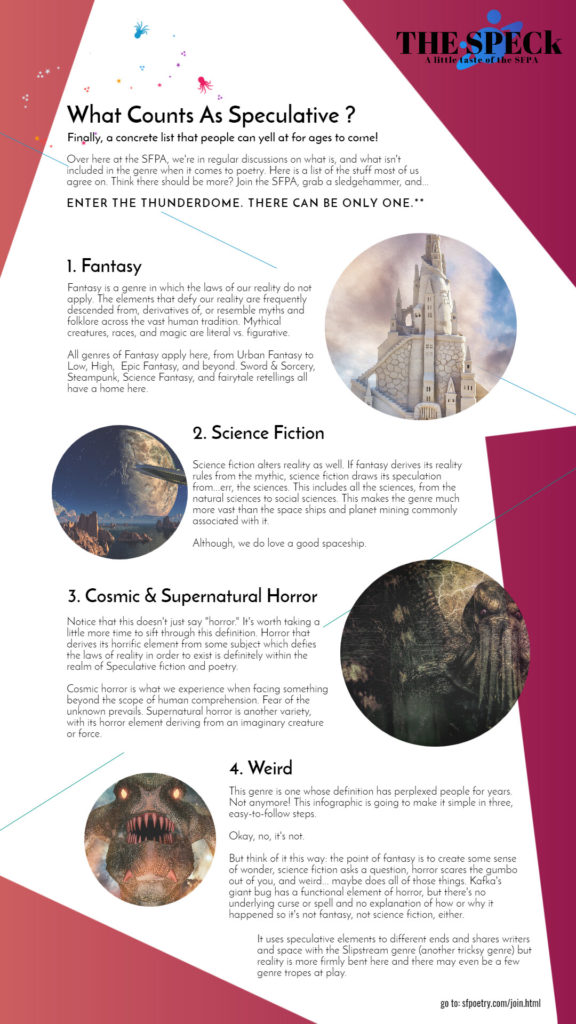
(10) MEDIA BIRTHDAY.
- September 4, 1966 — At Tricon in Cleveland, Ohio, Gene Roddenberry debuted Star Trek‘s “Where No Man Has Gone Before” episode. It was so well received that fans there demanded that he show them the black-and-white print he had with him of “The Cage”, the original Star Trek pilot. (Neither would win the Hugo for Best Dramatic Presentation at NyCon 3 the next year as that would instead go to Trek’s “Menagerie“ episode, a reworking of “The Cage”.) Thus was born the popular legend that credits September 4th, 1966 as the true birth date of the Star Trek franchise.
(11) TODAY’S BIRTHDAYS.
[Compiled by Cat Eldridge and John Hertz.]
- Born September 4, 1905 — Mary Renault. ISFDB only counts her Theseus series work as genre novels (The King Must Die and The Bull from the Sea) by her. Is that right? I’m not familiar with her full body of work to say if that is or is not correct. (Died 1983.) (CE)
- Born September 4, 1916 – Robert A.W. “Doc” Lowndes. (Surname is one syllable, rhymes with astounds.) Founded the Stamford, Connecticut, chapter of the SF League, 1935. Edited Dynamic, Famous, Future, SF Quarterly, SF Stories; various other prozines outside our field. Founded Vanguard Records with James Blish. Four novels, fifty shorter stories, poems, under many different names. Nonfiction Three Faces of SF, The Gernsback Days (with M. Ashley), Bok (with C. Beck, H. Bok, J. Cordes, G. de la Ree, B. Indick). Guest of Honor at Lunacon 12, Boskone 10. Best-known fanzine Le Vombiteur; several more. First Fandom Hall of Fame. (Died 1998).
- Born September 4, 1919 – Evelyn Copelman. After the Denslow-illustrated 1900 Wizard of Oz fell out of print, EC illustrated a 1944 ed’n showing the influence of the 1939 motion picture; then a 1947 Magical Monarch of Mo, and a further 1956 Wizard. Outside our field, many illustrations, another career in graphic design. (Died 2003)
- Born September 4, 1924 — Joan Aiken. I’d unreservedly say her Wolves Chronicles were her best works. Of the many, many in that series, The Wolves of Willoughby Chase featuring the characters of Bonnie Green, Sylvia Green and Simon is I think the essential work to read even though The Whispering Mountain is supposed to a prequel to the series I don’t think it’s essential reading. (Or very interesting.) The Wolves of Willoughby Chase is certainly the one in the series I see stocked regularly in my local bookstores. (Died 2004.) (CE)
- Born September 4, 1928 — Dick York. He is best remembered as the first Darrin Stephens on Bewitched. He was a teen in the police station in Them!, an early SF film which is considered the very first giant bug film. He’d showed up in myriad Alfred Hitchcock Presents, several episodes of Twilight Zone and has a one-off on Fantasy Island. He voiced his character Darrin Stephens in the “Samantha” episode of The Flintstones. (Died 1992.) (CE)
- Born September 4, 1957 — Patricia Tallman, 63. Best known as telepath Lyta Alexander on Babylon 5, a series I hold that was magnificent but ended somewhat annoyingly. She was in two episodes of Next Generation, three of Deep Space Nine and two of Voyager. She did uncredited stunt work on further episodes of the latter as she did on Voyager. H’h to the latter. Oh, and she shows up in Army of Darkness as a possessed witch. (CE)
- Born September 4, 1962 – Karl Schroeder, 58. A dozen novels, thirty shorter stories. With Cory Doctorow, The Complete Idiot’s Guide to Publishing SF. Essays, reviews in Analog, Bifrost (French), Locus, NY Review of SF, On Spec. Interviewed in Challenging Destiny, Clarkesworld, Lightspeed. Two Prix Aurora awards. Ventus a NY Times Notable Book. Past President of SF Canada (nat’l ass’n of SF pros). [JH]
- Born September 4, 1963 – Linda Davies, 57. Six novels for us; Longbow Girl was the Mal Peet Children’s Book of the Year. Several others. Escaped, as she put it, from investment banking to write fiction, naturally including financial thrillers. [JH]
- Born September 4, 1963 – Mike Scott, 57. His adventures with the much-loved fanzine PLOKTA, the Journal of Superfluous Technology (= Press Lots Of Keys To Abort), involved him with the PLOKTA Cabal, two Hugos, and notoriety as Dr. Plokta. Chaired CUSFS (Cambridge Univ. SF Soc.) and led the successful bid to hold Loncon 3 (72nd Worldcon). Married the horsewoman and fan Flick, another cabalist. [JH]
- Born September 4, 1972 — Françoise Yip, 48. She was a remarkably extensive career in genre productions including Earth: Final Conflict, Andromeda, Caprica, Fringe, Robocop: Prime Directives, Seven Days, Flash Gordon, Smallville, Millennium, Arrow and Sanctuary. Genre casting directors obviously like her. (CE)
- Born September 4, 1973 – Jennifer Povey, 47. Seven novels, forty shorter stories; role-playing games. Horsewoman. Ranks The Moon Is a Harsh Mistress above Level 7, with which I agree. Collection, The Silent Years. [JH]
- Born September 4, 1975 — Kai Owen, 45. Best known for portrayal of Rhys Williams in Torchwood, the Doctor Who spin-off I stopped watching after the first two series. He reprised his character in the Big Audio and BBC audio dramas. (CE)
(12) BOSEMAN TRIBUTE. Following the passing of Chadwick Boseman last week, the late actor has now been honored with a new piece designed by Ryan Meinerding, Head of Visual Development for Marvel Studios.
(13) THUMB DOWN. Vanity Fair’s Richard Lawson pans the remake: “Disney’s New Mulan Is a Dull Reflection of the Original”.
… Having affirmed its place in the firmament of animated classics, Mulan could have enjoyed a nice retirement. But Disney as it exists now is not content to let things rest, and so—after tackling live-action remakes of Cinderella, Beauty and the Beast, Aladdin, and Alice in Wonderland—they turned their necromancy to Mulan. Only, certain mores and cultural interests have changed in the last 22 years, meaning Disney didn’t feel quite comfortable simply literalizing the 1998 film, talking dragon and musical numbers and all. Instead, they wanted a big action epic in the style of many huge movies that have come out of the Chinese film industry, only directed by a New Zealander, Niki Caro.
Caro directed the lovely New Zealand coming-of-age tale Whale Rider, which earned its young star, Keisha Castle-Hughes, an Oscar nomination for best actress. In that way, she was a fine pick for Mulan, another coming-of-age story about a headstrong young woman bucking the rigid gender norms of her place and time. In other ways—being that Caro is not from China or of Chinese descent—her hiring rang alarm bells. Disney had to proceed carefully, not wanting to tarnish valuable I.P. or create a cultural blowback that would put its corporate progressiveness under the microscope.
What has resulted from all that needle threading is a movie, out on Disney+ on September 4, that’s been managed to death. The new Mulan is a sweeping action movie with lots of cool fight choreography, and yet it never musters up a sense of awe. Even the loathsome Beauty and the Beast remake was not this bland and perfunctory; that film at least had the darkly electrifying jolt of its awfulness. Mulan is not awful. It’s just inert, a lifeless bit of product that will probably neither satisfy die-hards nor enrapture an entire new generation of fans.
(14) BORNE AGAIN. Nina Shepardson reviews “‘Borne’ by Jeff VanderMeer” at Outside of a Dog.
Although I first encountered Jeff VanderMeer through the excellent anthologies he co-edits with his wife Ann, he’s better known for his fiction. His Southern Reach Trilogy and Ambergris novels are both beloved by fans of weird fiction. Borne is the first in a trilogy set in a post-apocalyptic city where people scavenge for biotechnological creations that have escaped into the wild while trying to evade a giant flying bear. No, that was not a typo, there really is a giant flying bear. His name is Mord….
(15) DICELIVING. Camestros Felapton proposes an easy way for sff critics to save themselves the trouble of constantly rearranging those reviewers’ clichés in “Get a free opinion about science in science fiction”.
You’ll need a D20 dice and the table below. Take the sentence “I believe that the science in science fiction should be X and Y” and replace X and Y with entries from the table, rolling the dice twice to get your exciting new take on the discussion….
(16) THE ROOM WHERE IT HAPPENED. [Item by Martin Morse Wooster.] I heard a 2019 podcast Leonard and Jessie Maltin did with Brad Bird (Maltin on Movies — Brad Bird). Bird explained that he first visited Disney in 1968, when he was 11. Three years later, he sent them a 15-minute animated film. This was a time when character animation was at its low point, where the only studio producing character animation was Disney, who produced one film every three years. Most of the animators who started working with Disney in the 1930s were still active 30 years later, but they realized they had no successors, so Bird was recruited. He discusses his apprenticeship with the great animator Milt Kahl and then went on to study at Cal Arts, where the one class for character animators met in the basement in room A113. Bird has remained friends with many of the students in that class, including Henry Selick, Tim Burton, and John Musker, and sticks “A113” as an Easter egg in all of his films. Also discussed: what Bird did for “The Simpsons,” and his surprise at being drawn as the villain Syndrome in The Incredibles.
(17) ASK NASA. NASA’s Science Mission Directorate will hold a community town hall meeting with Associate Administrator for Science Thomas Zurbuchen and his leadership team at 12 p.m. EDT Thursday, Sept. 10, to discuss updates to NASA’s science program and the current status of NASA activities.

Members of the science community, academia, the media, and the public are invited to participate by joining at the link here. (If prompted, please use event number 199 074 4251, followed by event password Zk4n3G48gbd.)
To ask a question, participants can go here.
Users must provide their first and last name and organization and can submit their own questions or vote up questions submitted by others. The meeting leaders will try to answer as many of the submitted questions as possible.
Presentation materials will be available for download and a recording will be available later that day here.
(18) L. RON HUBBARD, COMMANDING. [Item by Dann.] I came across something interesting via one of my regular YouTube channels; The History Guy. THG is prepared by an actual history professor.
In this case, he was offering a window into the history of WWII vintage anti-submarine ships of the US Navy.
One of those ships, PC-815, reportedly engaged with a pair of Japanese submarines just off the northwestern coast of the United States. The sub-chasers expended all of their depth charges and had called in two blimps in pursuit of the two submarines.
In his lengthy and quite descriptive after-action report, the captain of the PC-815 claimed to have positively sunk one of the submarines and damaged the other. The after-action reports of the other US Navy air and sea vessel commanders involved in the chase did not support that claim.
Shortly thereafter, the PC-815 was diverted from coastal defense duty and was assigned to escort a ship down to San Diego for final outfitting. Upon arrival, the captain of the PC-815 had the ship moored off of some area islands and decided to conduct some nighttime gunnery exercises using those islands as targets. The islands belonged to Mexico and were defended by an installation of Mexican army soldiers.
Shortly thereafter, the captain of the ship, one L. Ron Hubbard, was removed from command and reassigned to other…non-command….duties.
If you want to skip to the part about Hubbard, it’s at the 12:33 mark of the video.
Other links are to the ever-questionable Wikipedia. Those pages seem to match up well with other sites that aren’t affiliated with the Scientology folks.
[Thanks to John Hertz, John King Tarpinian, Dann, Mike Kennedy, Michael Toman, Martin Morse Wooster, JJ, Cat Eldridge, and Andrew Porter for some of these stories. Title credit goes to File 770 contributing editor of the day Andrew (not Werdna).]

